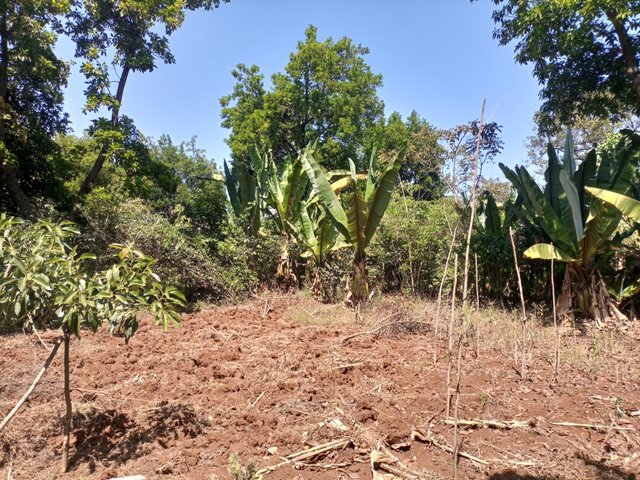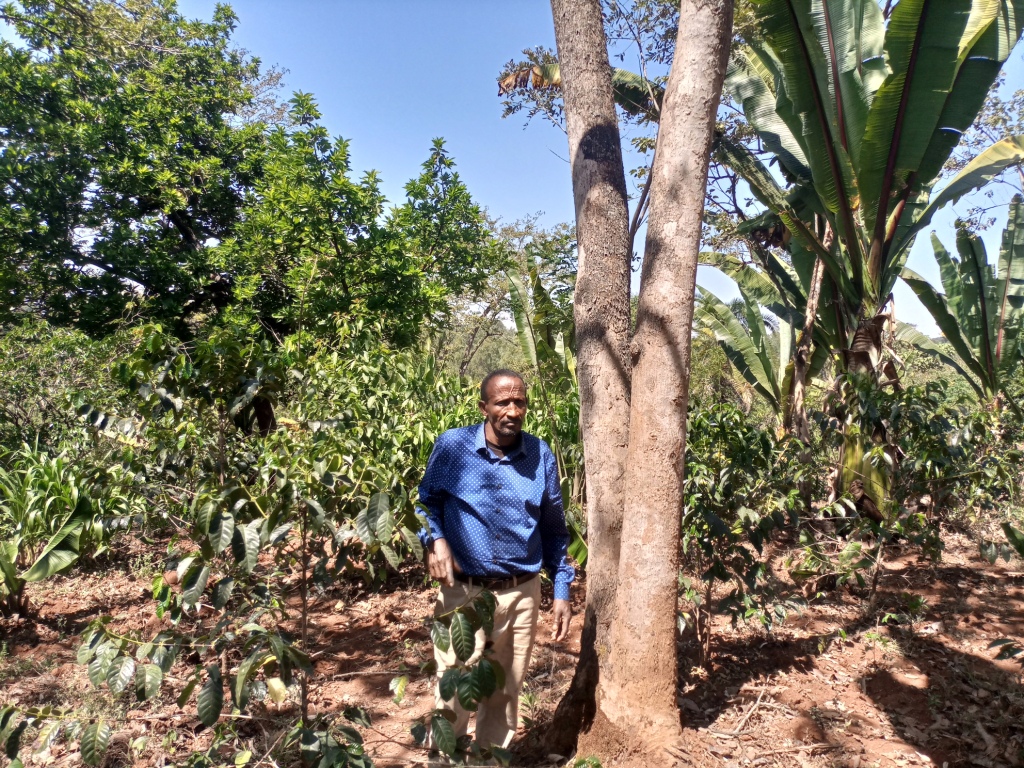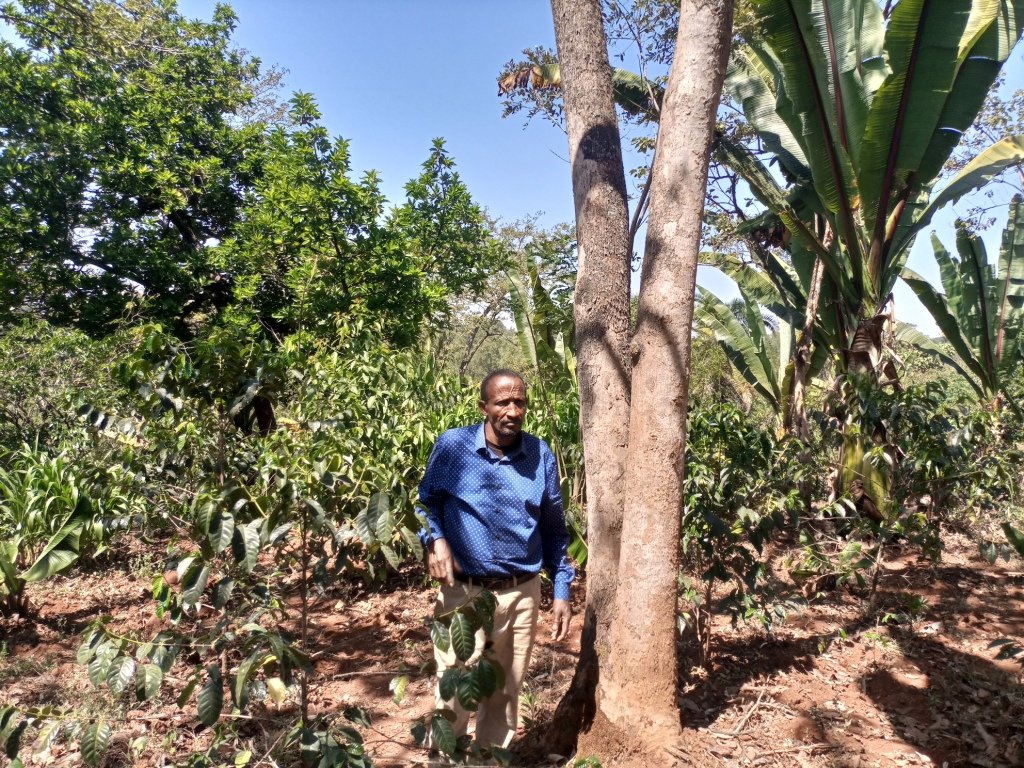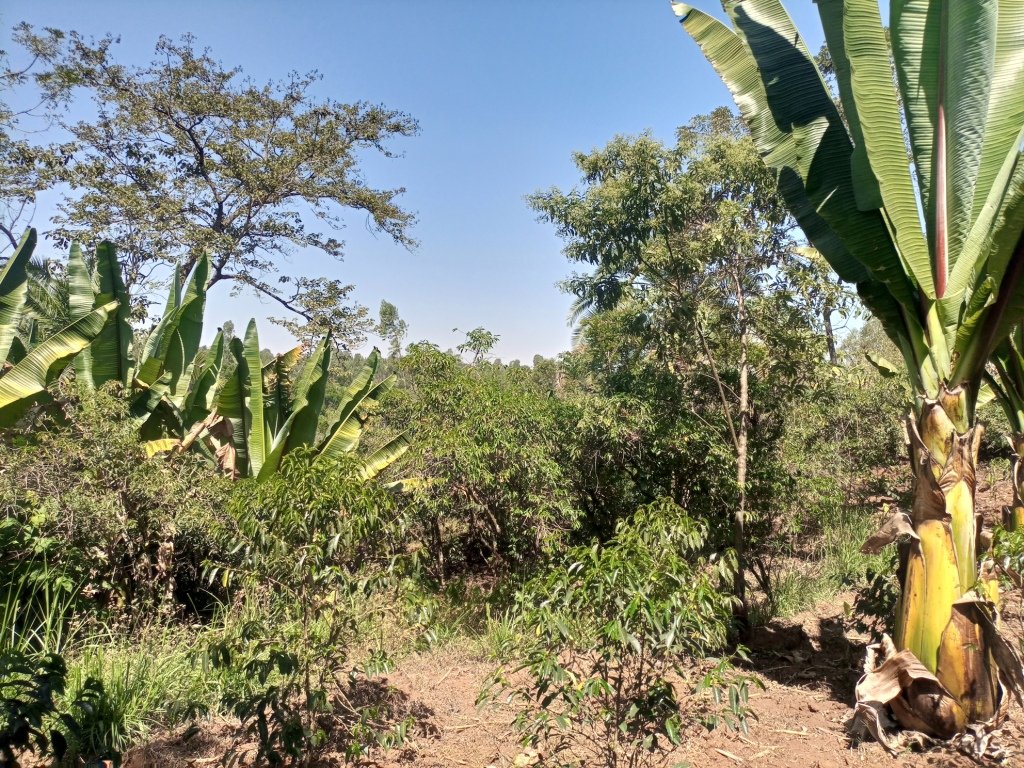Integrated Agroforestry System [Etiopía]
- Creación:
- Actualización:
- Compilador: GERBA LETA
- Editores: Julia Doldt, Noel Templer, Kidist Yilma, Tabitha Nekesa, Ahmadou Gaye, Siagbé Golli
- Revisores: William Critchley, Rima Mekdaschi Studer, Sally Bunning
Mitikarsamino Ersha
approaches_6622 - Etiopía
Visualizar secciones
Expandir todo Colapsar todos1. Información general
1.2 Detalles de contacto de las personas de referencia e instituciones involucradas en la evaluación y la documentación del Enfoque
Persona(s) de referencia clave/s
Usuario de la tierra:
Gabiba Afra
+251 934 73 5738
Farmer
Dale District, Shoye kebele Sidma Regional State Ethiopia
Etiopía
Nombre del proyecto que facilitó la documentación/ evaluación del Enfoque (si fuera relevante)
Soil protection and rehabilitation for food security (ProSo(i)l)Nombre de la(s) institución(es) que facilitaron la documentación/ evaluación del Enfoque si fuera relevante)
Alliance Bioversity and International Center for Tropical Agriculture (Alliance Bioversity-CIAT) - Kenia1.3 Condiciones referidas al uso de datos documentados mediante WOCAT
¿Cuándo se compilaron los datos (en el campo)?
13/01/2023
El compilador y la/s persona(s) de referencia claves aceptan las condiciones acerca del uso de los datos documentados mediante WOCAT :
Sí
1.4 Referencia/s al/los Cuestionario(s) de Tecnologías MST

Multistorey agroforestry [Etiopía]
Multistorey agroforestry is the intentional mixing of trees/shrubs with crops, pastures, and livestock. The practice creates environmental, economic, and social benefits for the end users.
- Compilador: GERBA LETA
2. Descripción del Enfoque MST
2.1 Breve descripción del Enfoque
The integrated agroforestry system is a self-initiated approach by a land user to implement agroforestry as part of an indigenous practice and has evolved over the years through technical support, training, and supplies of coffee and tree seedlings by the Office of Agriculture and Coffee Improvement Project. Had there been a participatory process throughout it would have helped in design and also in scaling up.
2.2 Descripción detallada del Enfoque MST
Descripción detallada del Enfoque MST:
The integrated agroforestry system was independently initiated by land users during the Derg regime (1974-91). During the regime, farmers were failed by two distinct and polar development approaches: socialist and the mainstream local approaches. The earlier one involved the communist approach of communal production and sharing the output according to contribution. The latter ones employed a conventional approach and included non-members of the so-called Farmers Producer Cooperatives. As a non-member of the earlier one, the land user had to develop his farm alone. The solitary agroforestry initiative described here has gradually evolved to a fully-fledged system that currently serves as a model SLM practice for scaling up across similar agroecological and farming system. Thus, there was little participation involved during the early intensification of agroforestry in Ethiopia. Rather, it is considered an indigenous practice that now receives publicity as a form of “regenerative agriculture” with ecological, economic, and social benefits. As it has global significance in terms of emission reduction and sequestration of carbon, it is the favourite technology among the government and other development practitioners.
The farmer started agroforestry by planting enset and coffee. Over time, with emerging technical support, access to training, and supply of coffee seedlings by the agriculture and coffee improvement project offices, the land user has continued intensification of the agroforestry around the homestead by adopting the correct planting space for coffee and enset, and other companion fruit, fodder crops, and shade trees. The former Ministry of Coffee and Tea, and the current Ministry of Agriculture have had an immense contribution by supplying technical support, training, and inputs (notably coffee and tree seedlings), and by ensuring access to fertilizers. The latter was supplied to the farmers on a credit basis through the then Service Cooperative.
As the initiative was the farmer's own, the tendency to plant incompatible crops was not uncommon. Even so, the agroforestry trees and shrubs still had immense ecological and economic value. They ameliorate the extreme temperature experienced during the dry season, improve the microclimate, recharge the surface and groundwater via improving water infiltration, and reduce runoff losses. Improving soil fertility and soil health are among other benefits. Despite the substantial benefit the technology confers on land users, the lack of a participatory approach in planning, implementation, monitoring, and evaluation at the community level restricts the adoption and scaling up of this beneficial approach. Despite the achievements of the land user, earlier engagement of other smallholders and institutionalizing the approach decades ago might have positively influenced the design as well as wider-scale adoption and application of the technology. However, regardless of any limitations, the technology is evidence-based and inspirational.
2.3 Fotos del Enfoque
Comentarios generales sobre las fotos:
The photo shows the practice rather than the approach. However, the existing scene is just the outcome of the approach (farmer's own) employed to establish and maintain the agroforestry practice.
2.4 Videos del Enfoque
Comentarios, descripción breve:
Videos of the approach is not documented.
2.5 País/ región/ lugares donde el Enfoque fue aplicado
País:
Etiopía
Región/ Estado/ Provincia:
Sidama
Especifique más el lugar :
Shoye kebele (Kebele - lower administrative level).
Comentarios:
As perennial crop enset (false banana) is a staple food in the area, the farming system is tree based but vary with degrees of intensification.
Map
×2.6 Fechas de inicio y conclusión del Enfoque
Indique año del inicio:
1980
Comentarios:
It is a continuous, non-ending self initiative inheritable by the generation to come.
2.7 Tipo de Enfoque
- tradicional/ local
2.8 Propósitos/ objetivos principales del Enfoque
A traditional approach was initiated to change the land use/ land cover and optimize the benefit of the degraded land by reducing the negative effects of overgrazing and its consequence.
2.9 Condiciones que facilitan o impiden la implementación de la/s Tecnología/s aplicadas bajo el Enfoque
normas y valores sociales/ culturales/ religiosos
- facilitan
The long-standing tradition of the society promotes planting and preserving trees.
disponibilidad/ acceso a recursos y servicios financieros
- facilitan
Access to in-kind credit services such as fertilizers from farmers' cooperatives enables the land users to effectively implement the practice.
entorno institucional
- impiden
The lack of institutional setting might have influenced the rate of scaling the technology.
colaboración/ coordinación de actores
- facilitan
Foster farmers access to training, technical support, exchange visit...
marco de trabajo legal (tenencia de tierra, derechos de uso de tierra y agua)
- facilitan
Enables the development of a sense of ownership and accountability to properly implement and manage the practice.
conocimiento de MST, acceso a apoyo técnico
- facilitan
Promote effective implementation, management, and use of the return from the practice.
mercados (para comprar insumos, vender productos) y precios
- facilitan
The availability of a fair and subsidized market enables the approach.
- impiden
Lack of reliable market compels to change the approach to another income-generating practice/approach.
carga de trabajo, disponibilidad de mano de obra
- facilitan
The availability of manpower enables one to accomplish the job without pressure.
- impiden
Shortage of manpower disables effective implementation of the practice.
3. Participación y roles de las partes interesadas involucradas
3.1 Partes interesadas involucradas en el Enfoque y sus roles
- usuarios locales de tierras/ comunidades locales
Land users and local communities
Plan and implement the technology, and sharing labor, skills and knowledge.
- especialistas MST/consejeros agrícolas
Development agents (DAs) and district experts
Provide training, and technical support, facilitate land users' access to inputs such as seedlings and fertilizers, monitor and evaluate, and documentation of successful practices for pervasive application and use.
- investigadores
Regional Agricultural Research Institute, and under/graduate students.
Generate supportive specific and relevant technologies, learn the lesson, and recommend best-fit technologies/practices.
- gobierno local
District administration and colleagues
Acknowledge the farmers/technology adopters as a model to showcase their experience and encourage the scaling out of the initiative.
3.2 Involucramiento de los usuarios locales de tierras/ comunidades locales en las distintas fases del Enfoque
| Involucramiento de los usuarios locales de tierras/ comunidades locales | Especifique quién se involucró y describa las actividades | |
|---|---|---|
| iniciación/ motivación | auto-movilización | Land user: Initiated coffee and enset plantation little by little and accessed training and technical support from DAs and Woreda office of Agriculture experts. |
| planificación | auto-movilización | Land user and development agent: In consultation with DAs, the land users plan based on available labor and capital every other year. |
| implementación | auto-movilización | Land users and family member. They involved in various implementation/management activities. |
| monitoreo y evaluación | pasivo | Government development agents, and experts coordinate mobilization of the communities to visit and learn from the ongoing practice. |
3.3 Flujograma (si estuviera disponible)
Descripción:
A flow chart depicting the evolution of practice from self-initiative indigenous coffee planting practices to a multistorey agroforestry system with the participation and support of public organization agents and farmers' primary cooperative.
Autor:
Gerba Leta
3.4 La toma de decisiones en la selección de Tecnología(s) MST
Especifique quién decidió la selección de las Tecnología/ Tecnologías a implementarse:
- solamente usuarios de tierras (autoiniciativa)
Explique:
The land user was the initial decision maker that later cross-fertilized or complemented by research and development actors.
Especifique las bases que sustentaron la toma de decisiones:
- la experiencia personal y opiniones (no documentadas)
4. Apoyo técnico, fortalecimiento institucional y gestión del conocimiento
4.1 Construcción de capacidades / capacitación
¿Se proporcionó la capacitación a usuarios de tierras/ otras partes interesadas?
Sí
Especifique quién fue capacitado:
- usuarios de tierras
- Development agents
Si fuese relevante, también especifique género, edad, estatus, etnicidad, etc.
Training is usually provided to literate farmers who are capable of reading, taking notes, and sharing with other peers back home. Women-headed household are inclusive to represent the gender parity.
Forma de capacitación:
- reuniones públicas
Forma de capacitación:
- Training and visit
Temas avanzados:
Coffee production and management such as preparation of planting pits, refilling the soil back to the pit, planting space, fertilizer application, weeding, mulching, planting shade trees, etc.
Comentarios:
Integrating enset, shade trees, and soil bunds with productive barriers into the farm eventually evolves into the agroforestry system.
4.2 Servicio de asesoría
¿Los usuarios de tierras tienen acceso a un servicio de asesoría?
Sí
Especifique si servicio proporcionado se realizó:
- en los campos de los usuarios de tierras
- en centros permanentes
Describa/ comentarios:
The training used to be given in permanent centers such as development stations in the past and Farmers Training Center since recent a decade ago and was associated with a visit to a farmers field.
4.3 Fortalecimiento institucional (desarrollo institucional)
¿Se establecieron o fortalecieron instituciones mediante el Enfoque?
- no
4.4 Monitoreo y evaluación
¿El monitoreo y la evaluación forman parte del Enfoque?
No
Comentarios:
A sort of visit may be organized by development agents to the coffee plantation but not in a way address the role of monitoring and evaluation and documentation.
4.5 Investigación
¿La investigación formó parte del Enfoque?
No
5. Financiamiento y apoyo material externo
5.1 Presupuesto anual para el componente MST del Enfoque
Si no se conoce el presupuesto anual preciso, indique el rango:
- < 2,000
Comentarios (ej. fuentes principales de financiamiento/ donantes principales):
Only in kind support such as coffee seedlings and technical support such as advisory service was provide by the government agricultural office through development/extension agents. Otherwise, it is privately financed business with main expense geared toward supplying seedlings and agricultural inputs such as fertilizers.
5.2 Apoyo financiero/material proporcionado a los usuarios de tierras
¿Los usuarios de tierras recibieron financiamiento/ apoyo material para implementar la Tecnología/ Tecnologías? :
Sí
Si respondió sí, especifique el tipo o los tipos de apoyo, condiciones y proveedor(es) :
In the past (during Derg regime) there was subsidy for fertilizers as a country which is entirely removed in the recent years.
5.3 Subsidios para insumos específicos (incluyendo mano de obra)
- otro
| Otro (especifique) | En qué grado | Especifique los subsidios |
|---|---|---|
| Fertilizer | parcialmente financiado | In the past, the government import and supply fertilizer on subsidized basis. The trend was changed over the last a couple of decades. |
Si la mano de obra de usuarios de tierras fue un insumo sustancial, ¿fue:
- voluntario?
Comentarios:
Family labor used to manage the family farm.
5.4 Crédito
¿Se proporcionó crédito bajo el Enfoque para actividades MST?
No
5.5 Otros incentivos o instrumentos
¿Se usaron otros incentivos o instrumentos para promover la implementación de Tecnologías MST?
No
6. Análisis de impacto y comentarios de conclusión
6.1 Impactos del Enfoque
¿El Enfoque empoderó a los usuarios locales de tierras, mejoró el involucramiento de las partes interesadas?
- No
- Sí, un poco
- Sí, moderadamente
- Sí, mucho
The approach was mainly based on self initiative. The assistance that came in later on was top-down where farmers were urged to plant coffee and companion tree crops. However, later it has evolved into agroforestry and SLM that empower local land users to join.
¿El Enfoque facilitó la toma de decisiones basada en evidencia?
- No
- Sí, un poco
- Sí, moderadamente
- Sí, mucho
It is not entirely the approach but the outcome of intensifying the technology that eventually enables land users and other stakeholders to make an evidence-based decision.
¿El Enfoque ayudó a los usuarios de tierras a implementar y mantener Tecnologías MST?
- No
- Sí, un poco
- Sí, moderadamente
- Sí, mucho
The prevailing system compels farmers to integrate land management practices such as soil bunds, food and non-food tree species into the farm that enable land users to adopt and uphold SLM technology.
¿El Enfoque mejoró la coordinación e implementación efectiva en costos de MST?
- No
- Sí, un poco
- Sí, moderadamente
- Sí, mucho
¿El Enfoque movilizó/mejoró el acceso a recursos financieros para implementar MST?
- No
- Sí, un poco
- Sí, moderadamente
- Sí, mucho
,
¿El Enfoque mejoró el conocimiento y capacidades de los usuarios para implementar MST?
- No
- Sí, un poco
- Sí, moderadamente
- Sí, mucho
Through public meetings and social learning from peers and better-off farmers, land users' knowledge and skills to implement the technology have been improved.
¿El Enfoque mejoró el conocimiento y capacidades de otras partes interesadas?
- No
- Sí, un poco
- Sí, moderadamente
- Sí, mucho
Virtually through social learning and labor sharing.
¿El Enfoque construyó/ fortaleció instituciones, colaboración entre partes interesadas?
- No
- Sí, un poco
- Sí, moderadamente
- Sí, mucho
It was a solitary approach but later adopted by numerous land users.
¿El Enfoque mitigó conflictos?
- No
- Sí, un poco
- Sí, moderadamente
- Sí, mucho
¿El Enfoque empoderó a grupos en desventaja social y económica?
- No
- Sí, un poco
- Sí, moderadamente
- Sí, mucho
It doesn't deliberate about gender disparity and equity as it was an indigenous initiative in the long past.
¿El Enfoque mejoró la equidad de género y empoderó a las mujeres y niñas?
- No
- Sí, un poco
- Sí, moderadamente
- Sí, mucho
¿El Enfoque alentó a jóvenes/ la siguiente generación de usuarios de tierras a involucrarse con MST?
- No
- Sí, un poco
- Sí, moderadamente
- Sí, mucho
The established technology built youths trust in SLM.
¿El Enfoque mejoró cuestiones de tenencia de tierra/ derechos de usuarios que obstaculizaron la implementación de la Tecnologías MST?
- No
- Sí, un poco
- Sí, moderadamente
- Sí, mucho
¿El Enfoque resultó en mejor seguridad alimentaria/ mejoró la nutrición?
- No
- Sí, un poco
- Sí, moderadamente
- Sí, mucho
Actually, implementing the agroforestry improved food and nutrition security of the family farmers.
¿El Enfoque mejoró el acceso a los mercados?
- No
- Sí, un poco
- Sí, moderadamente
- Sí, mucho
Harvest from the integrated system improved farmer's access to market.
¿El Enfoque llevó a un acceso mejorado a tierra y saneamiento?
- No
- Sí, un poco
- Sí, moderadamente
- Sí, mucho
¿El Enfoque llevó a un uso más sostenible/ fuentes de energía?
- No
- Sí, un poco
- Sí, moderadamente
- Sí, mucho
Through promoting biogas technology in mixed tree-crop-livestock system.
¿El Enfoque mejoró la capacidad de los usuarios de tierras a adaptarse a los cambios climáticos/ extemos y mitigar desastres relacionados al clima?
- No
- Sí, un poco
- Sí, moderadamente
- Sí, mucho
Again, it is not the approach but the applied technology has improved farmers adaptation to climate change/climate variability.
¿El Enfoque llevó a oportunidades de empleo, ingresos?
- No
- Sí, un poco
- Sí, moderadamente
- Sí, mucho
It creates all year round employment opportunity for family labor and other casual laborers.
6.2 Motivación principal del usuario de la tierra para implementar MST
- producción incrementada
Improve crop production and productivity; diversify crops and reduces risks of crop failure; improved soil fertility and reduce runoff.
- incremento de la renta(bilidad), proporción mejorada de costo-beneficio
Land users managed to generate income from the sale of cash crops such as coffee, and fruits as compared to the investment in managing the system.
- reducción de la degradación de la tierra
Permanent land cover by trees, shrubs, and perennial food, cash, and fodder crops reduces land degradation. Also, enrich the land with litter and organic matter.
- reducción del riesgo de desastres naturales
Reduce the risk of flood and soil runoff, diversify crops and reduce the risk of failure owning to climate change/variability.
- prestigio, presión social/ cohesión social
Land user becoming the richest in the community implies earning from the investment makes her/his prestigious within the community.
- conciencia medioambiental
The reduction of adverse effects due to the implementation of the technology allows for an increase in environmental consciousness.
- conocimiento y capacidades mejorados de MST
6.3 Sostenibilidad de las actividades del Enfoque
¿Pueden los usuarios de tierras sostener lo que se implementó mediante el Enfoque (sin apoyo externo)?
- sí
Si respondió que sí, describa cómo:
Despite the implementation approach employed by the land user, the technology is highly commended by the land users and the public at large. The income generated from the sale of crops adequately supports the livelihoods of family farmers as well as effectively finances the maintenance of the system. However, the new beginners need external support to make sure the technology is properly implemented and scaled out for wider application and use.
6.4 Fortalezas/ ventajas del Enfoque
| Fuerzas/ ventajas/ oportunidades desde la perspectiva del usuario de la tierra |
|---|
| Enables improved crop production and productivity and reduces risks of crop failure due to climate change/variability. |
| Motivate farmers to reduce soil erosion and land degradation and improve soil fertility. |
| The approach creates an enabling environment to intensify agroforestry and improve the microclimate of the area and ensure sustainability of the system. |
| Increased land users' status in the community to feel confident as local elites and friendliness to the environment. |
| Fuerzas/ ventajas/ oportunidades desde la perspectiva del compilador o de otra persona de referencia clave |
|---|
| The agroforestry system creates economic, ecological, and social benefits for the family farm. |
| It ensures sustainable land management becomes in place as well as improves land users' understanding of SLM. |
| Ensure productivity and product stability, and serve as a permanent source of income and insurance for a family farmer. |
6.5 Debilidades/ desventajas del Enfoque y formas de sobreponerse a ellos
| Debilidades/ desventajas/ riesgos desde la perspectiva del usuario de la tierra | ¿Cómo sobreponerse a ellas? |
|---|---|
| Failure to promote collective action that end up with shortage of labor with increasing size/ areas of technology. | Establish and promote collective action and labor-sharing techniques. |
| Lack of participatory planning and decision make to put in place proper trees-crops integration. | Promote participation that enables to select and plant trees and crops with desirable characteristics to the agroforestry system. |
| Lack of active women participation with clear role and their share of the benefit from the system. | Improve women's participation and share of the benefit. |
| Debilidades/ desventajas/ riesgos desde la perspectiva del compilador o de otra persona de referencia clave | ¿Cómo sobreponerse a ellas? |
|---|---|
| Lower level of mainstreaming the approach and the technology at earlier stage that led to land users lower level of understanding of the multi-storey agroforestry system. | Improve land users understanding of Agroforestry and the SLM through capacity building and exchange visits. |
| The solitary approach led to relatively lower adoption of the technology. | Improve participation, access to training, technical support, and credit services to optimize the benefit of land users at scale. |
| Evolving the approach from solitary approach to large mass of land users constrained by shortage of farmland. | Promote intensification through introduction of high - value crops and optimize the return from the smaller holdings. |
7. Referencias y vínculos
7.1 Métodos/ fuentes de información
- visitas de campo, encuestas de campo
3
- entrevistas con usuarios de tierras
One land user
- entrevistas con especialistas/ expertos en MST
2
7.2 Referencias a publicaciones disponibles
Título, autor, año, ISBN:
An Agroforestry Guide for Field Practitioners. 2013. ISBN 978-92-9059-333-1
¿Dónde se halla disponible? ¿Costo?
https://www.worldagroforestry.org
7.3 Vínculos a la información relevante disponible en línea
Título/ descripción:
SUSTAINABLE LAND USE FORUM
URL:
http://publication.eiar.gov.et
Vínculos y módulos
Expandir todo Colapsar todosVínculos

Multistorey agroforestry [Etiopía]
Multistorey agroforestry is the intentional mixing of trees/shrubs with crops, pastures, and livestock. The practice creates environmental, economic, and social benefits for the end users.
- Compilador: GERBA LETA
Módulos
No se hallaron módulos






